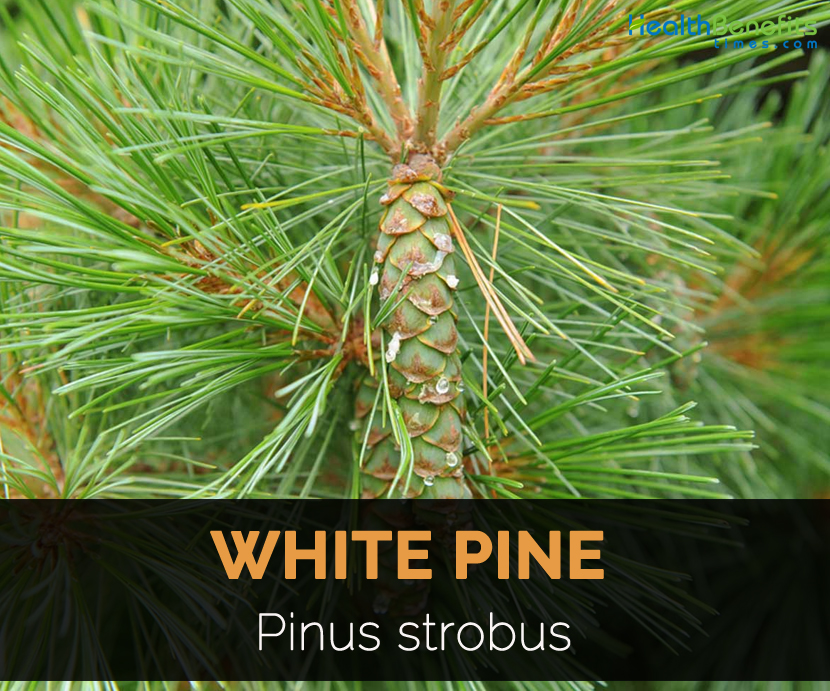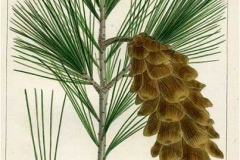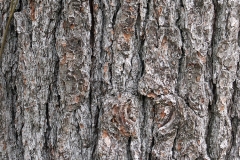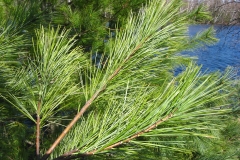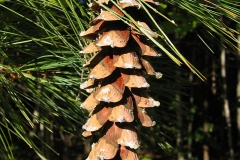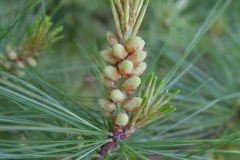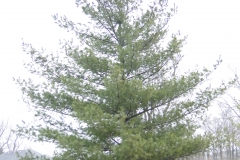| White Pine Quick Facts | |
|---|---|
| Name: | White Pine |
| Scientific Name: | Pinus strobus |
| Colors | Brown |
| Shapes | Elongated, 6 to 12 inches |
| Name | White Pine |
|---|---|
| Scientific Name | Pinus strobus |
| Common/English Name | Soft Pine, Deal Pine |
| Name in Other Languages | Arabic: Sanawbar, Khashab ‘azîzî, Sanawbar abyad amrîkî; Catalan: Pi de Weymouth, Pi blanc americà, Pi strobus, Pi blanc del Canadà; Chinese: Bei mei qiao song (北 美乔松), Bai song (白 松), xxx wu zhen song (美国五针松), Měiguó báisōng (美国白松); Czech: Borovice hedvábná, Borovice vejmutovka; Danish: Weymouths-Fyr; Dutch: Weymouth-den, Weymouthsden, Weymouthpijn; English: American white pine, Cork pine, Eastern white pine, New England pine, Northern white pine, Ottawa pine, Ottawa white pine, Pattern pine, Pumpkin-pine, Soft pine, Weymouth pine, White pine; Finnish: Strobusmänty, Weymouthmänty; French: Pin à aiguilles fines, Pin baliveau, Pin blanc de l’Est, Pin de Lord Weymouth, Pin de Weymouth, Pin blanc d’Amérique, Pin Weymouth; German: Büschelkiefer, Gemeine Weimutskiefer, Weymouthsföhre, Weymouthskiefer, Weymouths-Kiefer; Hungarian: Simafenyő, Weymouth fenyõ; Icelandic: Vætufura, Weymouthfura; Italian: Pino di Weymouth, Pino bianco, Pino strobo; Japanese: Sutoroobu matsu (ス トローブマツ), Sutoroobusu matsu (ストローブスマツ); Norwegian: Weymouthfuru; Polish: Sosna Amerykańska, Sosna wejmutka; Portuguese: Pinheiro-do-lorde, Pinheiro-de-Weymouth, Pinheiro-branco-do-Canadá; Russian: Sosna veimutova (Сосна веймутова); Slovakian: Borovica hladká; Spanish: Pimobete blanco, Pino blanco americano, Pino de Quebec, Pino de Weymouth; Swedish: Ostlig vittall, Weymouthtall; Turkish: Beyaz çam fıstık ağacı |
| Growing Climate | Cool, humid |
| Soil | Well-drained |
| Bark | Gray-brown, deeply furrowed |
| Leaf | Spreading to ascending, 6-10 cm x 0.7-1 mm |
| Buds | Ovoid-cylindric, light red-brown, 0.4-0.5 cm |
| Fruit shape & size | Elongated, 6 to 12 inches |
| Fruit color | Brown |
| Seed | Compressed, broadly obliquely obovoid, 5-6 mm |
| Medicinal parts | Inner bark or sprigs |
Uses
The pine trees play an important part in the domestic life of the Indian. They use pine needles for sewing, resins as cement, and the nuts as food and decoration. The appealing use as medicine and food is, to us, the most outstanding. Pine nuts were made into a paste consistency and added to soups for infants and adults. They chewed the gum resin for sore throats; the same was also dried, powdered and applied to the throat with a swab. The resin and parts of some other plants such as small twigs of Juniper (Juniperus osteosperma) were used as a tea for colds, rheumatism, tuberculosis, influenza and chronic indigestion, kidney trouble, etc. The bark and new sprigs are useful as an expectorant, to modify quality and quantity of the mucus secretions and to favour its removal in bronchial and catarrhal trouble, rheumatism, scurvy, all chest affections, tonsilitis, laryngitis, croup and the like.
It is best to combine 1 teaspoonful of each of the following with 1 pint of water: Wild cherry bark (Prunus serotina), Sassafras (Laurus) and Spikenard (Aralia racemosa); steep ½ hr.; administer ½ teaspoonful to a mouthful every hour, depending on age and condition. Of use in diabetes with Uva ursi (Arctostaphylos), Marshmallow (Avthea) and Poplar bark (Populuas tremuloides). Prepare as above and take 3–4 cupfuls daily of the tincture, ½–1 fl dram.
Externally
The heated resin is used as a dressing to draw out imbedded splinters or to bring boils to a head; sores, cuts, swellings and insect bites also respond favourably. The hot resin can be spread on a hot cloth and applied as you would a mustard plaster for treating pneumonia, sciatic pains and any general muscular soreness.
Medicinal uses
- North American Indian tribes use it for antiseptic and vulnerary qualities.
- It is used for treating skin complaints, burns, wounds and boils.
- It is used to treat coughs, influenza, colds and others.
- Use it internally as a rub or steam bath for treating rheumatic affections.
- The poultice of pitch is used to draw out toxins from boils and lower pain.
- An infusion is used for treating colds and as an ingredient in commercial cough syrups for promoting expulsion of phlegm.
- Use the pounded inner bark for treating cuts, sores and wounds.
- Use the wetted inner bark as a poultice on chest for treating strong colds.
- The infusion of young twigs is used for treating kidney disorders and pulmonary complaints.
- Use the powdered wood as a dressing on baby’s chaffed skin, improperly healed navels and sores.
- Tea prepared from young needles is used for treating sore throats.
Culinary uses
- Seeds are consumed raw or cooked.
- Use the seeds to flavor cooking.
- Brew the fresh needles into an aromatic tea.
- Boil the tender new shoots in syrup to make a candy.
- Sticky amber sap is used for chewing.
- Use it as a thickener in soups or add it to cereals for making bread.
Precautions
- Resins, wood and sawdust can cause dermatitis in sensitive people.
- Allergic people should avoid it.
- People with asthma or bronchitis should avoid it.
References:
https://www.itis.gov/servlet/SingleRpt/SingleRpt?search_topic=TSN&search_value=183385#null
http://www.hear.org/pier/species/pinus_strobus.htm
https://pfaf.org/user/Plant.aspx?LatinName=Pinus+strobus
http://hort.ufl.edu/database/documents/pdf/tree_fact_sheets/pinstrd.pdf
http://www.naturalmedicinalherbs.net/herbs/p/pinus-strobus=white-pine.php
https://pfaf.org/user/Plant.aspx?LatinName=Pinus+Strobus
http://www.euforgen.org/species/pinus-strobus/


